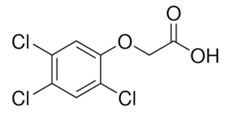 What is 2,4,5-T?
What is 2,4,5-T?
2,4,5-T was once applied as either an aqueous salt or as an oil-soluble ester.
Uses
Ester forms of 2,4,5-T and 2,4-D were used as defoliants in the Vietnam War (e.g., Agent Orange) and concern about contamination with 2,3,7,8-tetrachlorodibenzo-p-dioxin (TCDD) led to the discontinuation of 2,4,5-T use as a herbicide in 1985.
Sources & Potential Exposure
The half-life of 2,4,5-T in soil varies with conditions, ranging from several weeks to many months. 2,4,5-T degrades to 2,4,5-trichlorophenol and other degradants. 2,4,5-T has been rarely detected in ground waters. Given the unavailability of 2,4,5-T, the general population is unlikely to be exposed to 2,4,5-T. Although 2,4,5-T is rapidly absorbed via oral and inhalation routes, it is not well absorbed through the skin. Human health effects from 2,4,5-T at low environmental doses or at bio monitored levels from low environmental exposures are unknown.
Federal Regulations
While 2,4,5-T has not been identified by the EPA as a carcinogen, it should be handled with caution since several related compounds are carcinogens.
REGENESIS Treatment Products – 2,4,5-T

 Americas
Americas Europe
Europe Français
Français Deutsch
Deutsch Italiano
Italiano Español
Español
